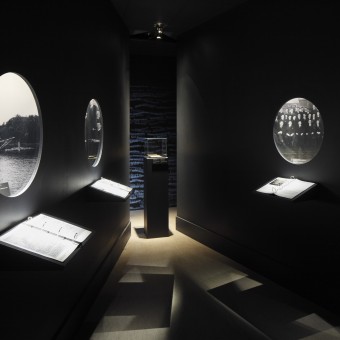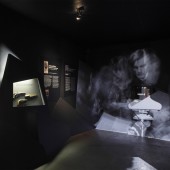10 Stories about Man and Power Exhibition design by Design Studio H2E |
Home > Winners > #36675 |
 |
|
||||
| DESIGN DETAILS | |||||
| DESIGN NAME: 10 Stories about Man and Power PRIMARY FUNCTION: Exhibition design INSPIRATION: A combination of different inspirational aspects persisted during the design development stages. Firstly, 10 main objects and many more artifacts that reveal the relationships between people and authority in the 20th century. Secondly and particularly, the emotional stories that stand behind the objects. Lastly, the historical context of one of Soviet era Riga's most notorious building, the KGB Building, where the post-Soviet style exhibition premises are situated. UNIQUE PROPERTIES / PROJECT DESCRIPTION: The aim of the exhibition design is to interpret the premises and the building's history to a new contextual level where 10 objects are the main communicators. The concept of the exhibit is merging of 10 rooms, 10 main objects and 10 story lines showing the relationships between people and authority in the 20th century. One unitary emotional line is created with the help of such means as video projections, lighting, supplementing sounds and scenographical elements. OPERATION / FLOW / INTERACTION: The visitor experiences exhibition once he enters the first room. The exhibition design addresses the visitors' perception directly without faltering. As the visitor enters one room after another his experience is slowly transformed while the hallway is comparatively unpretentious. The authentic objects interact with visitors and help them understand the historically significant context while inviting them to reconstruct it. The interaction is fostered with the help of such media as audio, video, lighting. PROJECT DURATION AND LOCATION: The project started in November 2013 and finished in October 2014. Exhibition was opened to public from May 2014 to October 2014 in Riga, Latvia, KGB Building. FITS BEST INTO CATEGORY: Interior Space and Exhibition Design |
PRODUCTION / REALIZATION TECHNOLOGY: As the exhibition design is aimed to facilitate visitor's subjective emotional perception of the historical facts, each of the 10 rooms immerse visitors in different emotional experience. A fundamental and conjunctive form, rooms as neutral and dark groundworks for reconstruction of the history, is used. Accordingly, the individual dramaturgy of every room, namely specific historical objects, video projections, lighting, supplementing sound, foster carefully planned emotions. SPECIFICATIONS / TECHNICAL PROPERTIES: 10 rooms and a hallway form the total exhibition area of 228 m2. The temporary exhibition was located on the 4th floor of the Soviet-era Riga's most notorious building, namely the KGB Building. There were used different types of materials depending on the room-glass, digital print, wood board, accordion-pleated cardboard, chipboard, wooden beams, metal net, barbed wire, cotton fabric, old & authentic furniture. TAGS: Temporary exhibition, Historical objects as storytellers, Scenographical exhibition, Stories about man and power, emotional adventure RESEARCH ABSTRACT: The primary aspect of the qualitative research were the stories behind the objects. The stories were rich in details and interesting facts so we needed to bolt the most essential parts. Afterwards we brainstormed about the means of telling the emotional message so that the visitor immerses in it immediately. Also taking in mind the exhibition premises, 10 rooms and a hallway, we needed to create one conjunctive scenography so that the main objects are the main storytellers. CHALLENGE: The biggest creative challenge during the research of the project was the question what kind of expressional means to use in order to tell the story and make it as an emotional adventure. Also not to forget that the story must be understandable and easily perceptible. It was also challenging to find such means that correspond with the limited budget of the project. ADDED DATE: 2014-09-24 07:00:52 TEAM MEMBERS (1) : Design Studio H2E IMAGE CREDITS: Image #1: Photographer Ansis Starks, Story of the Book, 2014 Image #2: Photographer Ansis Starks, Story of the Accordion, 2014 Image #3: Photographer Ansis Starks, Story of the Sweets box, 2014 Image #4: Photographer Ansis Starks, Story of the Badly Wounded Patient's Card, 2014 Image #5: Photographer Ansis Starks, Story of the Cigarette Case, 2014 |
||||
| Visit the following page to learn more: http://h2e.lv/?lang=en | |||||
| AWARD DETAILS | |
 |
10 Stories About Man and Power Exhibition Design by Design Studio H2e is Winner in Interior Space and Exhibition Design Category, 2014 - 2015.· Read the interview with designer Design Studio H2E for design 10 Stories about Man and Power here.· Press Members: Login or Register to request an exclusive interview with Design Studio H2E. · Click here to register inorder to view the profile and other works by Design Studio H2E. |
| SOCIAL |
| + Add to Likes / Favorites | Send to My Email | Comment | Testimonials | View Press-Release | Press Kit |
Did you like Design Studio H2e's Interior Design?
You will most likely enjoy other award winning interior design as well.
Click here to view more Award Winning Interior Design.








